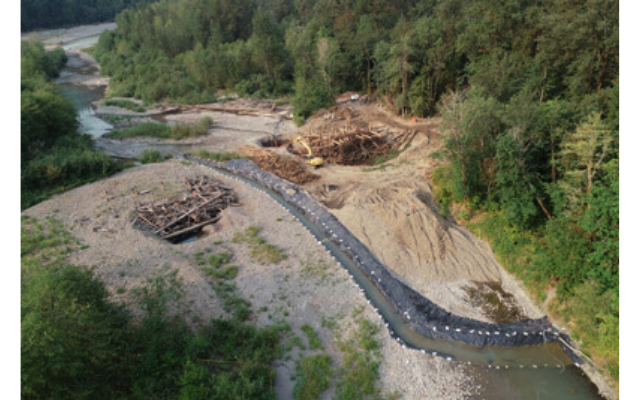- Human activity has contributed to significant declines in fish runs in Pacific Northwest rivers.
- Electric submersible pumps proved to be the ideal solution to keeping the work area dry, getting the job done faster.
- Contracted by local government agencies, an ecological restoration organization turned to Tsurumi pumps to help build fish spawning habitats along the Sandy River.
Upriver fish migration is one of nature’s most fascinating journeys. In northwestern Oregon, every year hundreds of thousands of fish take the perilous trip from the Pacific Ocean up the Columbia River and into its tributaries, returning to their place of birth to spawn and renew their life’s cycle. Since the roundtrip is done only once in their lifetimes for some species, its success is crucial to the survival of the wildlife in the region.
On the Sandy River, the lasting impact of a former hydroelectric dam, channelization, and road and bridge construction have posed serious threats to the delicate balance of the area’s animal and plant species, in particular fish runs. To mitigate the issue, local and state governments turned to a solution in which Tsurumi pumps were critical to the success of fish habitat restoration.
The agencies commissioned Biohabitats, an ecological restoration organization, to build new procreation habitats for salmon at two sites along Sandy River. The first in Oxbow Regional Park, and the second in Dabney State Recreation Area, about 30 miles west of downtown Portland.
Known as engineered log jams (ELJs), these built environments act as fish spawning refuges, providing a relatively safe setting for fish to lay and fertilize eggs.
“Think about ELJs as subterranean skyscrapers, made of logs, boulders and slash,” said Jacques Varvel, an ecological restoration specialist at Biohabitats. “The whole point of erecting these structures along the river’s side channels is that they work as spawning grounds, providing a relatively calm and safe environment for the fish to procreate before returning to the river and the ocean.”
According to Varvel, ELJs help the fish reconnect to their food plain, making more food available per juveniles, so they grow bigger before moving to the ocean, increasing their survivability rates.
To erect the log structures along Sandy River side channels, Biohabitats needed to dig 40-foot holes to build their foundation. The biggest challenge was to keep these holes dry during construction.
“We used six Tsurumi KRS2-B6 15 horsepower electric submersible pumps to dewater the holes. They operated 24/7 for nearly three months at a time during the two summers we worked in the area,” Varvel said. “We battled both surface and ground water, even as we were able to divert most of the side channel flow.”
Varvel said that working at such pristine, protected natural areas poses a series of challenges.
“It’s really important we go pro: we have to be able to count on the equipment we use, we have to be able to move large volumes of water reliably, consistently, and we have to have the support so when things go bad we can rectify the situation immediately,” he said.
Biohabitats commissioned CESSCO, a Portland, Oregon-based sales and rental house to provide pumps for the project. CESSCO has been a Tsurumi partner since 1989 and has a strong reputation in providing pumps and power generators on similar rehabilitation projects in the Pacific Northwest.
“One of the project’s goals was to keep impact at a minimum, and that’s why we recommended electric submersible pumps,” said Casey Perry, a pump and power sales and rentals specialist at CESSCO. “The pumps allowed for the construction of a very sturdy structure that can withstand flooding and other once-in-a-while weather events.”
With unexpected runoff being a concern, it was important that the pumps were capable of handling high volumes of water to keep the project on track. The KRS2-B6 pumps were placed in fish cages, which have screens to prevent fish from being sucked in.
“There’s not a lot of room for second chances in what we do,” Varvel said. “We’re governed by very strict windows – most of the work had to be done between June and September, when the juvenile fish population is low. We have to do huge amounts of work in a very short period of time. We have to be superefficient, and we know Tsurumi pumps are made for continuous, nonstop duty.”
The KRS2-B6 pumps boast a high-chrome impeller and a 1735-rpm motor, ensuring slower tip speed on the impeller. This promoted longevity when pumping the sand, rock particles, and other debris that may have been washed into the channel.
The natural areas where the project took place are managed by the Portland Water Bureau, which supplies the city with drinking water, Metro, the regional transportation agency, and the Oregon Parks and Recreation Department. Biohabitats worked closely with the agencies to adhere to regulations and conditions for the ELJs to be built.
“Once the work is done, the sites have to look like we were never there – no excavator tracks, no debris of any kind are left behind,” Varvel said. “The best way to minimize our impact in these environments is to get the work done as quickly as you can. Instead of diverting the channel water, we chose to pump the water out, which makes the construction job easier. Using pumps allows us to do the work much faster and better.”
The project, completed in both the 2018 and 2019 summers, has been so successful that Biohabitats was awarded “Engineering Excellence Award – Small Project of the Year 2019”.
“The best part of these interventions is coming back a year later to see that it is working,” said Varvel“You see fish coming and spawning. The Sandy River is one river in the Portland area in which the fish population numbers are improving. And that’s really our end-goal.”






